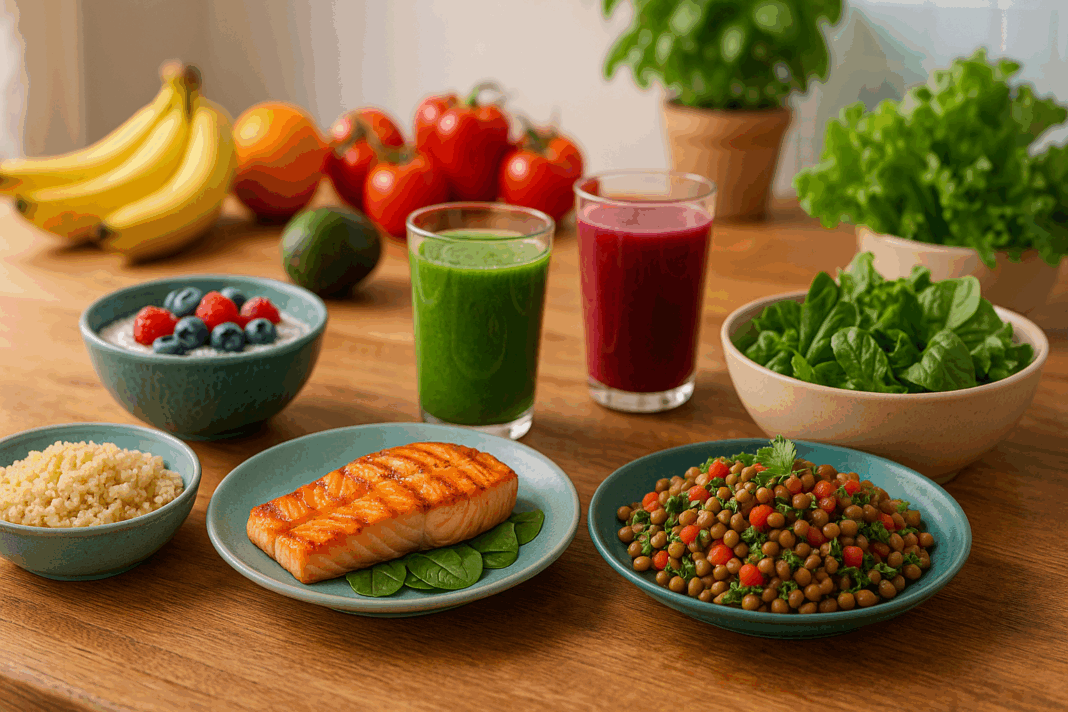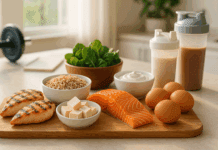In an age where fatigue and digestive discomfort have become all too common, nutrition stands as a powerful, modifiable tool to transform health from the inside out. A well-constructed high protein and fiber meal plan offers a strategic solution for those seeking to boost daily energy levels and enhance digestive function. By carefully selecting meals that prioritize these essential macronutrients, individuals can experience sustained vitality, improved metabolic resilience, and long-term gastrointestinal well-being. Unlike restrictive diets that focus solely on calorie reduction, this approach encourages nutrient density, variety, and satiety, ultimately aligning with both wellness and weight management goals.
You may also like : The Ultimate Guide to Choosing a High Protein Diet Name That Fits Your Goals
While protein is often celebrated for its role in muscle repair and metabolic activity, dietary fiber is equally deserving of attention. Fiber is the unsung hero of the digestive system, facilitating smoother bowel movements, stabilizing blood sugar, and supporting a healthy microbiome. Together, protein and fiber act synergistically to regulate hunger, enhance nutrient absorption, and promote sustainable energy without the typical crashes that follow carb-heavy meals. By curating a balanced intake of protein and fiber-rich foods, this meal plan not only addresses common digestive issues like bloating and irregularity but also nurtures the body’s natural energy cycles throughout the day.
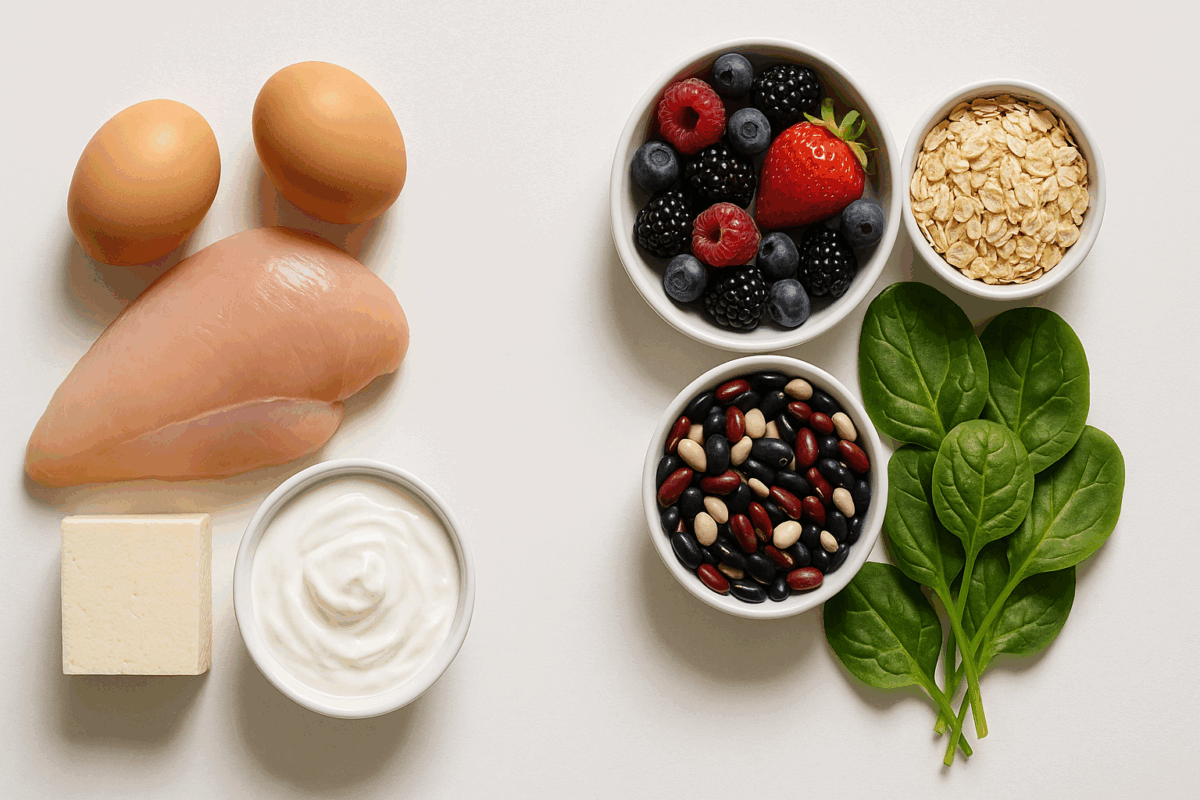
Why a High Protein and Fiber Meal Plan Is Key to Modern Wellness
A high protein and fiber meal plan is not merely a trend—it’s a science-backed method to optimize wellness at both cellular and systemic levels. Protein is vital for enzymatic function, hormonal signaling, tissue repair, and immune resilience. Fiber, particularly soluble fiber, plays a critical role in forming gel-like substances in the gut that slow digestion and contribute to feelings of fullness. Insoluble fiber, on the other hand, adds bulk to stool and accelerates waste elimination, ensuring toxins are efficiently removed from the body.
Moreover, this combination influences metabolic health markers such as insulin sensitivity, lipid regulation, and glycemic control. High protein and fiber diets have been shown to reduce the risk of chronic diseases, including type 2 diabetes, cardiovascular disorders, and even certain forms of cancer. By slowing the release of glucose into the bloodstream, these meals help maintain a steady energy supply, avoiding the peaks and troughs commonly associated with high-sugar or high-refined-carb diets. This stability is essential for cognitive function, emotional regulation, and physical performance.
Incorporating protein and fiber into every meal also supports satiety and portion control without relying on willpower alone. The physiological feedback from these nutrients reduces the likelihood of mindless snacking and late-night cravings, particularly for processed foods. This natural appetite regulation can aid those pursuing weight loss, body recomposition, or simply healthier eating habits. The result is a nourishing dietary structure that respects both the body’s immediate needs and its long-term vitality.
Choosing the Right Protein and Fiber Foods for Weight Loss and Energy
Creating an effective high protein and fiber meal plan begins with understanding the best sources of each nutrient. For protein, focus on lean options such as skinless poultry, fish, eggs, Greek yogurt, tofu, tempeh, legumes, and high-quality protein powders. These foods not only provide the amino acids required for muscle maintenance but also have thermogenic effects, meaning they increase the energy your body expends to digest them. This process, known as the thermic effect of food, plays a subtle but significant role in total daily energy expenditure.
Fiber, while less glamorous in conversation, is equally powerful. Beans, lentils, chickpeas, oats, chia seeds, flaxseeds, avocados, leafy greens, berries, and whole grains offer a rich supply of both soluble and insoluble fibers. These foods slow gastric emptying, reduce blood sugar spikes, and support satiety in ways that enhance both digestive and metabolic health. When paired with protein-rich foods, they create a balanced and highly satiating meal profile.
Importantly, many individuals ask, “Does protein have fiber?” The answer is generally no—most animal-based proteins contain negligible fiber, which underscores the need for deliberate pairing with fibrous plant foods. This reinforces the advantage of a combined approach that leverages the strengths of each macronutrient. Whether your goal is sustained energy, weight management, or digestive ease, choosing complementary foods from each category lays the foundation for long-term dietary success.

Morning Momentum: A High Protein and Fiber Meal Plan for Breakfast
The first meal of the day sets the tone for how your metabolism functions and how energized you feel in the hours that follow. Skipping breakfast or relying on processed carbohydrates can lead to blood sugar instability, cravings, and energy crashes. Instead, opt for a high protein and fiber breakfast that delivers sustained fuel and primes the digestive system for optimal function.
A simple yet powerful breakfast might include a vegetable omelet made with eggs, spinach, bell peppers, and onions, served with a slice of sprouted grain toast and a side of chia pudding. The eggs provide complete protein, while the vegetables and chia seeds offer fiber, omega-3 fatty acids, and antioxidants. Greek yogurt parfaits with berries, flaxseed, and a scoop of protein powder are another excellent choice that combines probiotics for gut health with a rich macronutrient profile.
Smoothies can also be tailored to meet these nutritional needs. Blend together unsweetened almond milk, frozen berries, spinach, a tablespoon of flax or chia seeds, and a scoop of plant-based protein powder for a quick, energizing option. The key is to avoid added sugars and prioritize ingredients that contribute to fullness and functional energy. These breakfasts not only taste delicious but also embody the best of a high protein and fiber diet by delivering nutrients that enhance cognition, mood, and gastrointestinal harmony.
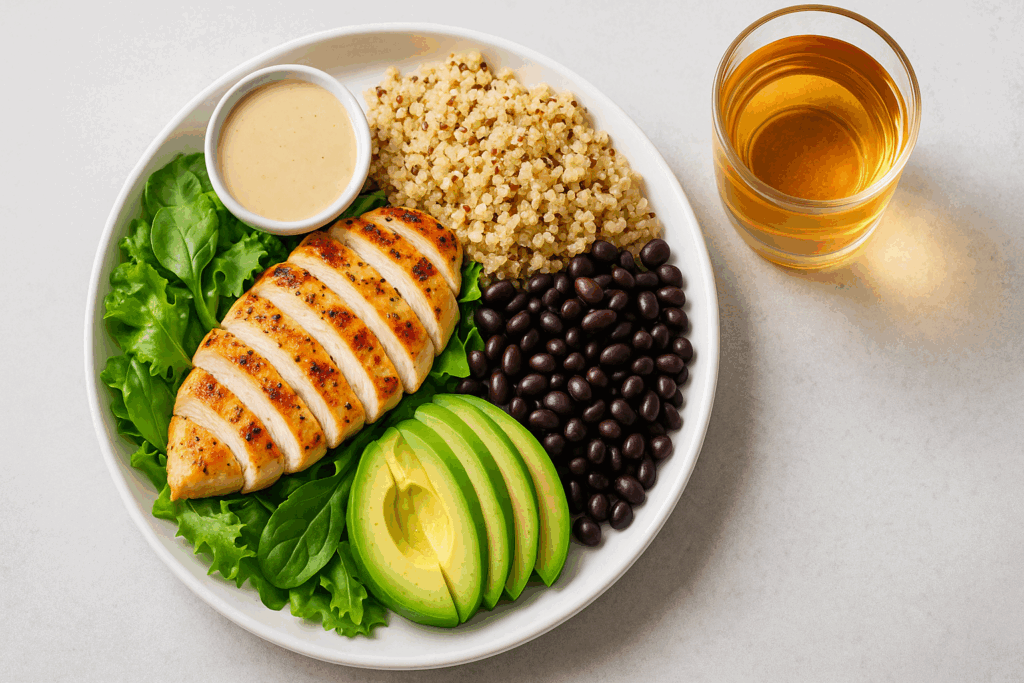
Midday Fuel: Structuring Lunch with Fiber and Protein Foods for Weight Loss
Lunchtime often presents a critical moment to either maintain energy levels or succumb to the post-meal slump. A balanced midday meal should reinforce the momentum set by breakfast while preparing the body for a productive afternoon. A high protein high fiber diet for weight loss particularly shines at this time, offering both nourishment and appetite control.
A grilled chicken salad with mixed greens, quinoa, black beans, avocado, and a tahini-lemon dressing offers a diverse array of nutrients. Here, the chicken and quinoa provide protein, while the black beans and greens contribute substantial fiber. Adding healthy fats like avocado helps with the absorption of fat-soluble vitamins and further supports satiety. Alternatively, a lentil and vegetable soup paired with a hard-boiled egg or a serving of cottage cheese creates a warm, satisfying, and nutrient-dense lunch that fuels both mind and body.
Sandwiches can be upgraded to meet these goals as well. Use whole-grain or sprouted bread, lean turkey or tofu, hummus, and plenty of raw vegetables for a satisfying and fiber-rich meal. Be mindful of dressings and condiments that may contain added sugars or unhealthy fats. Instead, lean on herbs, mustard, or avocado spreads to enhance flavor without compromising health. By consistently choosing meals that combine fiber and protein, you help your body burn calories more efficiently while reducing the likelihood of mid-afternoon crashes or unnecessary snacking.
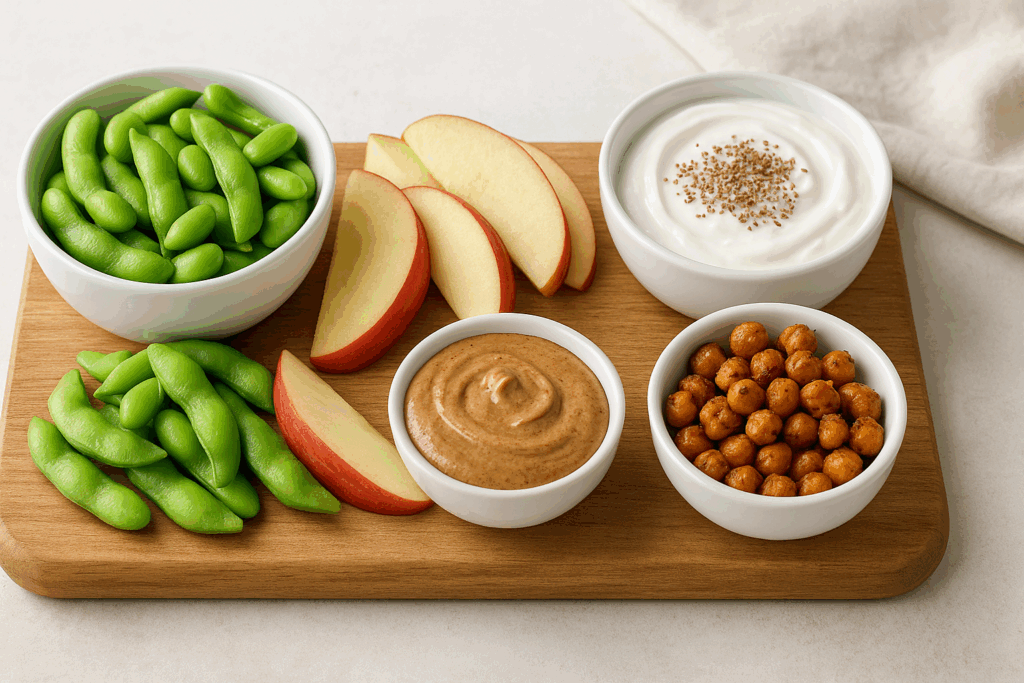
Smart Snacking Strategies for a Fiber and Protein Diet
Snacks serve a dual purpose: they can either support your health goals or derail them. For those following a high protein and fiber meal plan, snacks should continue the day’s nutritional rhythm by bridging gaps between meals with steady energy and digestive support. Rather than opting for highly processed snack bars or sugary items, consider whole food pairings that deliver both macronutrients.
A small bowl of edamame with sea salt, cottage cheese with sliced peaches, or a handful of roasted chickpeas are examples of snacks that balance protein and fiber seamlessly. Almond butter on apple slices, hard-boiled eggs with carrot sticks, or Greek yogurt with a tablespoon of ground flaxseed also meet these criteria. These combinations promote blood sugar stability and satiety, preventing the all-too-common pattern of overeating at dinner after a nutrient-poor afternoon.
Moreover, smart snacking encourages mindful eating. By preparing high-quality snacks ahead of time and keeping them readily available, individuals are more likely to maintain dietary consistency. This is particularly helpful when aiming for a high protein high fiber diet for weight loss, where avoiding extreme hunger is key to portion control. Strategic snacks ensure that your digestive system continues to receive the support it needs while aligning with your broader health and energy goals.
Evening Nourishment: Building a High Protein and Fiber Dinner That Satisfies
Dinner should be a time for recovery and replenishment, ideally without overwhelming the digestive system or disrupting sleep quality. A well-designed high protein and fiber meal plan considers the evening meal as an opportunity to restore muscle tissue, stabilize blood sugar overnight, and support the body’s natural detoxification processes through fiber-rich foods.
Grilled salmon or baked tofu served with steamed broccoli, roasted sweet potatoes, and a side of quinoa makes for an ideal dinner. The combination of protein, complex carbohydrates, and fiber-rich vegetables ensures a balanced and satisfying plate. Stir-fries using lean beef or tempeh, paired with bell peppers, cabbage, and brown rice, provide variety and valuable phytonutrients while maintaining the fiber and protein focus.
Soups and stews also offer a comforting way to integrate these nutrients. Try a white bean and turkey chili or a lentil and kale stew made with aromatic herbs and spices. These dishes not only nourish the body but are also easy to digest, making them suitable for the end of the day. As always, portion sizes and mindful eating matter—eat until satisfied, not stuffed, and let dinner be a calming close to your day’s nutritional efforts.
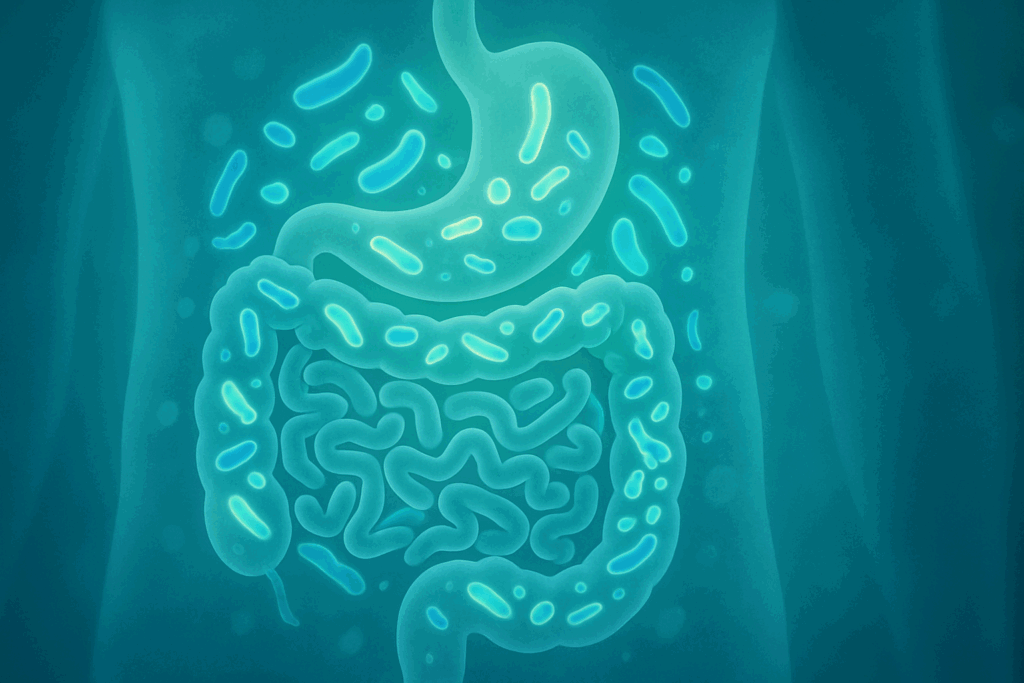
Gut Microbiome Modulation and Immune Function
Another powerful effect of a fiber and protein diet is its impact on the gut microbiota, the community of trillions of bacteria residing in the human digestive tract. Fiber, especially the prebiotic variety found in foods like garlic, onions, bananas, and chicory root, serves as nourishment for beneficial bacteria such as Bifidobacterium and Lactobacillus. These bacteria, in turn, produce short-chain fatty acids (SCFAs) that nourish colonocytes, enhance mucosal immunity, and reduce systemic inflammation.
While protein does not directly feed gut bacteria, it plays a supporting role by bolstering the immune system and maintaining the integrity of the intestinal barrier. High-quality proteins provide essential amino acids like glutamine, which is vital for maintaining the health of the intestinal lining. A compromised gut barrier, often referred to as “leaky gut,” has been linked to autoimmune disorders, allergies, and chronic fatigue. By combining fiber-rich plant foods with sufficient protein, the meal plan helps reinforce a robust and resilient gut-immune axis.
High Protein and Fiber Meal Plan for Weight Loss: A Weekly Template
For those specifically seeking to follow a high protein high fiber diet for weight loss, structure and variety are critical. A weekly meal template allows for easy planning and reduces decision fatigue, increasing adherence and long-term success. While rigid meal plans can become monotonous, a flexible framework built around favorite protein and fiber foods encourages sustainability.
Breakfasts can alternate between smoothies, egg-based dishes, and high-protein oatmeal with berries and seeds. Lunches may rotate between hearty salads, wraps using whole-grain tortillas, and warming grain bowls. Dinners can feature a rotation of lean meats, legumes, and fibrous vegetables, ensuring nutrient diversity. Snacks, meanwhile, remain consistent in their pairing of fiber and protein—whether it’s trail mix, hummus and veggies, or yogurt with seeds.
Importantly, this structure allows for intuitive eating. Listen to your hunger cues, stay hydrated, and remain attentive to how your body responds to different food combinations. Over time, you may notice improved digestion, clearer skin, better sleep, and more stable energy throughout the day. This reinforces the importance of both macronutrients, affirming their role in a successful weight loss and wellness journey.
The Synergy of Micronutrients in a High Protein and Fiber Diet
Beyond macronutrients, one of the often-overlooked benefits of a high protein and fiber meal plan is the enhanced bioavailability and absorption of critical micronutrients. Fiber-rich foods are naturally high in vitamins, minerals, and phytonutrients that work synergistically with dietary protein to optimize cellular function. For instance, leafy greens not only provide fiber but also deliver vitamin K, magnesium, and folate—nutrients essential for protein synthesis, red blood cell production, and bone metabolism.
Moreover, the inclusion of foods like legumes, seeds, and whole grains boosts the intake of iron, zinc, and selenium—minerals involved in energy metabolism, antioxidant defense, and immune health. When combined with vitamin C-rich fruits such as strawberries and citrus, the absorption of plant-based iron is significantly improved. This interplay of nutrients underscores the importance of dietary diversity and reinforces the notion that whole foods are far superior to isolated supplements in promoting health and vitality.
Addressing Common Misconceptions: Does Protein Have Fiber?
As discussed earlier, many people question whether protein has fiber, often assuming that all nutritious foods should contain both. In reality, most animal proteins are devoid of fiber, which can lead to digestive sluggishness if not paired with fibrous foods. This is why the high protein and fiber meal plan recommends integrating protein sources with vegetables, legumes, or whole grains to balance the meal.
However, some plant-based proteins—notably legumes, lentils, edamame, and tempeh—offer a rare dual benefit of containing both macronutrients. These foods simplify meal planning while reducing the need for additional components. They are especially valuable in vegetarian or vegan diets, where the need for diverse protein sources is paramount. Educating the public about the complementary nature of these foods can prevent nutritional gaps and enhance the efficacy of fiber and protein diets.
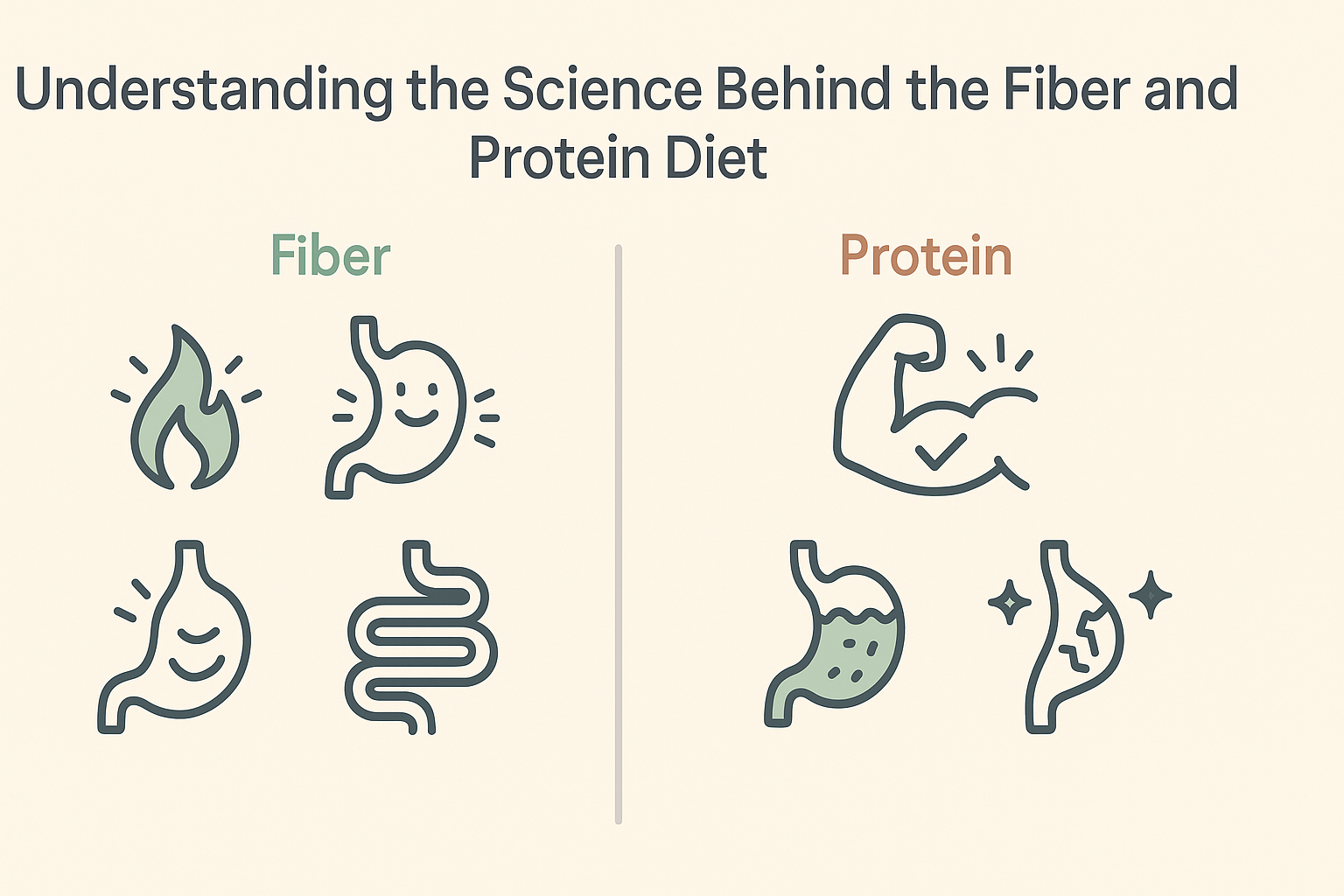
Understanding the Science Behind the Fiber and Protein Diet
To truly appreciate the effectiveness of a fiber and protein diet, it’s helpful to explore the underlying physiology. Protein requires more energy to digest than fats or carbohydrates, which means your body expends more calories during metabolism—a concept known as the thermic effect. Additionally, amino acids from protein are the building blocks of every cell, contributing to tissue repair, immune function, and neurotransmitter production.
Fiber, though indigestible by human enzymes, plays a profound role in gastrointestinal health. Soluble fiber acts as a prebiotic, feeding beneficial gut bacteria that produce short-chain fatty acids like butyrate. These compounds support colon health, regulate inflammation, and influence brain function through the gut-brain axis. Insoluble fiber, meanwhile, keeps bowel movements regular and detoxification pathways clear.
Together, protein and fiber reduce appetite hormones like ghrelin while increasing satiety hormones like peptide YY. This hormonal balance contributes to a natural decline in calorie consumption without feeling deprived. Over time, these shifts can support significant metabolic improvements, including better insulin sensitivity, reduced triglycerides, and leaner body composition—benefits that resonate far beyond the dinner plate.

Tailoring the Meal Plan for Special Populations and Medical Conditions
The flexibility of the high protein and fiber meal plan makes it ideal for customizing to suit various populations. For instance, older adults may require additional protein to combat sarcopenia (age-related muscle loss), while also benefiting from the digestive support that fiber provides. Including soft, digestible options like stewed lentils, scrambled eggs, and cooked vegetables ensures nutritional adequacy without gastrointestinal strain.
For individuals with diabetes, the meal plan’s emphasis on low-glycemic index foods and fiber helps regulate blood sugar levels and reduces insulin resistance. Pregnant and breastfeeding women, meanwhile, can adapt the plan by increasing calorie intake and focusing on nutrient-dense foods like salmon, avocados, and leafy greens, which provide essential omega-3s, folate, and iron.
People with gastrointestinal disorders such as IBS or Crohn’s disease may need to approach the diet with caution, opting for lower-FODMAP fibers and cooked rather than raw vegetables. Consulting with a registered dietitian can help tailor the plan appropriately, ensuring symptom management without sacrificing nutritional balance.
Fiber and Protein Foods for Weight Loss: Combining Flavor with Function
The best dietary plans don’t just support weight loss—they make it enjoyable. Fortunately, fiber and protein foods for weight loss include some of the most flavorful and versatile ingredients available. Think spiced lentil stews, grilled chicken with herbed vegetables, or roasted chickpeas tossed in olive oil and sea salt. These meals satisfy not only nutritional targets but also the senses, making adherence far easier.
Incorporating a variety of herbs, spices, and cooking techniques helps prevent boredom and promotes a greater intake of antioxidant-rich foods. Basil, turmeric, rosemary, garlic, ginger, and cumin all enhance both taste and health, contributing anti-inflammatory and digestive-supportive properties. The goal is to make meals that are deeply nourishing, exciting to prepare, and pleasurable to eat—a trio that is too often overlooked in rigid diet culture.
Ultimately, a high protein and fiber meal plan does not require sacrificing flavor for function. Instead, it invites creativity, exploration, and mindfulness around food. This positive relationship with eating enhances not just physical health, but emotional and mental well-being, reinforcing sustainable habits that truly last.
Frequently Asked Questions: Optimizing Your High Protein and Fiber Meal Plan for Lasting Wellness
1. How can I personalize a high protein and fiber meal plan for different metabolic types?
Personalizing a high protein and fiber meal plan involves understanding your body’s unique response to macronutrients. Individuals with faster metabolisms may require more calorie-dense fiber sources like legumes, oats, and avocado, paired with lean proteins to sustain energy. On the other hand, those with slower metabolisms might benefit from lighter fiber sources like leafy greens, berries, and cruciferous vegetables, combined with easily digestible proteins such as eggs or fish. Additionally, metabolic flexibility can be improved by varying the types of fiber and protein consumed across different meals. Experimenting with meal timing, glycemic load, and cooking techniques can help tailor the high protein and fiber diet to support optimal energy, digestion, and weight management outcomes.
2. What are the long-term benefits of staying consistent with a high protein and fiber meal plan?
While short-term improvements like better satiety and more regular digestion are commonly observed, the long-term benefits of a high protein and fiber meal plan extend far deeper. Over time, adherence to this type of eating can lower systemic inflammation, improve lipid profiles, and enhance insulin sensitivity. It also helps preserve muscle mass during aging, especially when paired with regular strength training, which is essential for metabolic health and injury prevention. Additionally, the sustained intake of diverse fiber types feeds a robust gut microbiome, which has been linked to cognitive resilience, immune health, and emotional regulation. These long-term adaptations make the fiber and protein diet a powerful ally in both preventive health and longevity.
3. How does a high protein high fiber diet influence mood and cognitive performance?
A high protein high fiber diet plays a significant role in brain function through several pathways. Protein supplies amino acids like tryptophan and tyrosine, which are precursors to neurotransmitters such as serotonin and dopamine, essential for emotional balance and mental focus. Fiber, meanwhile, supports the gut-brain axis by nourishing beneficial gut bacteria that produce short-chain fatty acids like butyrate, which influence mood and cognition. Studies suggest that individuals consuming consistent protein and fiber foods for weight loss or maintenance report fewer mood swings and better stress management. The stability in blood glucose levels from this type of meal plan also prevents the energy crashes that can lead to brain fog and irritability. Together, these nutrients form a neuroprotective diet that supports both daily productivity and long-term brain health.
4. Are there specific foods that naturally combine protein and fiber in one ingredient?
Yes, several plant-based foods naturally offer both protein and fiber in a single ingredient, making them highly efficient for meal planning. Lentils, black beans, chickpeas, quinoa, and edamame are prime examples of protein and fiber foods for weight loss that are both versatile and nutrient-dense. Tempeh and chia seeds also offer a rich blend of these macronutrients, along with added benefits like healthy fats and micronutrients. Including these foods regularly in your meals simplifies the process of meeting daily fiber and protein targets without relying on complex meal combinations. For those transitioning to a high protein and fiber diet, these dual-function foods can serve as easy entry points that simplify shopping, prepping, and tracking.
5. What are the signs that your body is responding well to a high protein and fiber meal plan?
Within a few weeks of adopting a high protein and fiber meal plan, many people report noticeable changes in how their body feels and performs. Common positive signs include increased satiety between meals, improved stool consistency, reduced bloating, and more stable energy levels throughout the day. Mental clarity and mood stabilization often follow as blood sugar becomes more regulated and nutrient absorption improves. Over time, enhanced skin appearance, reduced cravings, and even better sleep quality may emerge as secondary benefits. These improvements indicate that your fiber and protein diet is supporting metabolic efficiency, hormonal balance, and digestive resilience—key indicators of optimal health.
6. Why does a high protein and fiber diet work well for sustainable weight loss?
A high protein and fiber diet supports sustainable weight loss by targeting the physiological mechanisms that influence hunger, digestion, and fat metabolism. Protein has a high thermic effect, meaning the body burns more calories digesting it, while fiber slows gastric emptying and reduces appetite hormones. This combination naturally decreases overall caloric intake without requiring extreme restrictions or discomfort. Furthermore, high protein high fiber diet for weight loss enhances lean muscle retention during calorie deficits, which keeps metabolism stable. The reduction in insulin spikes also encourages the body to tap into fat stores more efficiently. Altogether, this approach creates an environment where the body sheds fat without compromising essential muscle tissue or triggering rebound weight gain.
7. Does protein have fiber, and how should meals be adjusted to compensate?
The simple answer to the question “Does protein have fiber?” is no—animal-based proteins typically contain no fiber, which means meals need to be consciously balanced. To optimize digestion and prevent issues like constipation, every serving of meat, poultry, or fish should be paired with vegetables, whole grains, or legumes. For example, grilled chicken over a bed of quinoa and roasted Brussels sprouts creates a fiber-protein synergy that supports fullness and digestive health. Conversely, plant-based protein sources such as lentils or tempeh often contain both nutrients but may require pairing with healthy fats to enhance absorption of fat-soluble vitamins. Understanding this distinction allows for better construction of meals that are not only complete but also functionally supportive.
8. Can a high protein and fiber meal plan improve skin and hair health?
Yes, a consistent high protein and fiber meal plan can contribute significantly to skin clarity and hair strength. Proteins provide collagen-building amino acids like glycine and proline, which support skin elasticity and wound healing. Fiber helps detoxify the system by promoting regular elimination of waste, which reduces the burden on the liver and skin—the body’s largest detox organ. Additionally, many protein and fiber foods for weight loss such as pumpkin seeds, oats, and legumes contain zinc, biotin, and other nutrients essential for hair growth. When combined with adequate hydration and omega-3 fatty acids, this type of diet fosters an internal environment conducive to vibrant skin and resilient hair. These aesthetic benefits, while secondary, can further motivate adherence to the dietary plan.
9. How does a high protein and fiber meal plan impact intermittent fasting?
Incorporating a high protein and fiber meal plan into an intermittent fasting routine can significantly enhance its effectiveness. Because both protein and fiber slow digestion and increase satiety, meals eaten during feeding windows tend to keep you fuller for longer, reducing hunger during fasting periods. This makes it easier to adhere to time-restricted eating without experiencing energy crashes or cravings. For example, a post-fast meal of grilled salmon, lentils, and sautéed spinach provides lasting fuel and supports muscle repair. Moreover, the stabilization of blood sugar through this diet reduces the risk of reactive hypoglycemia, a common challenge during intermittent fasting. Overall, the synergy between nutrient timing and macronutrient quality deepens the metabolic advantages of both strategies.
10. What are the future trends in high protein and fiber nutrition?
Emerging trends in high protein and fiber nutrition point toward innovations in functional foods, personalized nutrition, and microbiome-friendly formulations. Companies are developing new protein and fiber-enhanced snacks made from algae, insects, and fermentation-based processes that offer sustainability alongside nutrition. Advances in nutrigenomics may soon allow people to customize their fiber and protein intake based on genetic predispositions and microbiome profiles. There’s also growing interest in food pairing algorithms and AI-assisted meal planning apps that optimize macronutrient timing for fitness or cognitive performance. As research continues to unravel the deep connections between the gut, brain, and metabolic health, the high protein and fiber meal plan will likely become a central pillar in preventive medicine and precision wellness. These innovations signal a future where individualized, data-driven nutrition is not only accessible but foundational to health care.
Conclusion: Harnessing the Power of a High Protein and Fiber Meal Plan
As we look to optimize our energy, digestion, and overall vitality, a high protein and fiber meal plan emerges as a foundational strategy. It bridges the gap between nourishment and enjoyment, functionality and flavor. By prioritizing protein for muscle support and metabolic strength, and fiber for digestive harmony and gut health, individuals can craft meals that serve their long-term goals while satisfying day-to-day cravings.
For those wondering, “Does protein have fiber?” the distinction becomes clear: while protein provides essential amino acids, it often lacks the indigestible plant matter that supports gastrointestinal function. Hence, a fiber and protein diet represents a synergistic union of these elements, offering both structural support and systemic balance. Whether your priority is weight loss, energy maintenance, or simply improved health, the integration of high-quality protein and fiber foods is an evidence-based, empowering approach.
In embracing a high protein high fiber diet for weight loss or wellness, remember that success lies not in perfection, but in consistency, flexibility, and self-awareness. By tuning into your body’s cues, experimenting with recipes, and focusing on whole food sources, you build a nutritional framework that supports you through every stage of life. This isn’t a short-term fix—it’s a lifestyle rooted in resilience, science, and the joy of eating well.
Further Reading:
Weight-loss Success Depends on Eating More Protein, Fiber while Limiting Calories, Study Finds
Fiber and Protein: Why a High Protein High Fiber Diet Will Change Your Life
30-Day High-Protein, High-Fiber Meal Plan for Weight Loss, Created by a Dietitian


